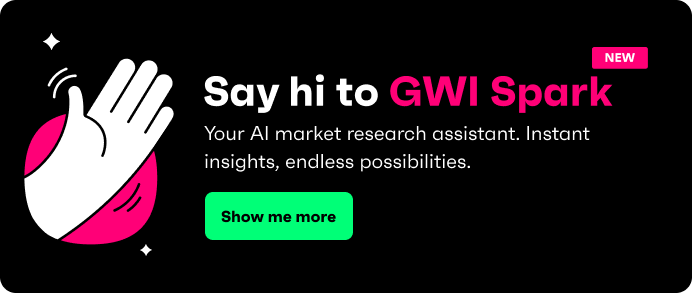
According to anthropologists, every culture in history has made use of stories in some form, showing it’s a deep part of our nature to absorb and enjoy information in narrative form.
Now if we think about organizations today, we know they’re absolutely swimming in data. But having access to it doesn’t necessarily mean making better decisions - unless you turn that data into a story that connects to your audience.
Building stories around data takes all this to the next level, bringing together two very different worlds to create data-driven stories.
By connecting the dots, highlighting what matters and guiding people toward action, you can transform this raw data into impact and strategy.
In this blog we’ll explore data storytelling, what it is, how to do it, and why it’s so important. Let’s go.
What is data storytelling?
Data storytelling is combining data, visuals, and a compelling narrative to communicate insights clearly and persuasively to a target audience. It’s not just presenting numbers or filling a slide deck, it means building a story that sparks understanding, builds belief, and drives business action.
Done right, data storytelling helps brands bring research to life. By turning insights into a story, you’re connecting consumer truths to strategies and decisions.
Data visualization vs data storytelling: what's the difference?
Not all data communication is created equal. Where a chart might show that sales dropped in Q4, a story built on insights explains why. It connects customer behavior shifts, market dynamics, and strategic recommendations into a clear path forward.
Data visualization is the art of organizing and presenting information in a visual format, like charts, graphs, and dashboards, to make the numbers easier to digest and more memorable. It helps you show data clearly and accurately.
Put simply:
- Data visualization organizes information.
- Data storytelling creates meaning from insights and drives decisions.
People read information, but they feel a good story.
By cleverly presenting data in a way that appeals to the heart as much as the mind, data storytelling enables brands to sidestep their audience’s mental defenses against sales messages and make their point almost by stealth.
Why data storytelling matters for brands and decision-makers
With all the information hitting us all day every day, it’s easy to miss what’s actually important. 65% of decision-makers say they feel overwhelmed by raw data, leaving them stuck.
But that’s exactly where storytelling steps in - turning complex consumer behavior into clear, actionable insights.
When brands tell a compelling story with data, they’re doing more than share information. They’re building understanding, sparking buy-in from stakeholders. They’re translating research into real-world campaigns that connect with needs and behaviors.
For advertisers, data storytelling is not just helpful, it’s essential. Sprawling consumer datasets are translated into campaign-ready insights that are timely, relevant, and perhaps most importantly, perform.
Key components of effective data storytelling
The key components of data storytelling are: data itself, which provides the factual backbone; a clear narrative, which pulls the whole thing together into a coherent data story; and appealing visuals, which bring the data story to life.
Ultimately, the best data stories are built on a few critical pillars that make insights stick.
Here’s what we mean by that.
1. Strong narrative structure
Every powerful story starts with strong structure, and by setting the context you will build the tension, and (hopefully!) deliver a resolution that brings the insight home.
Without a clear storyline, even the most critical data risks falling flat. A strong narrative weaved throughout keeps your audience engaged from the first slide to the final takeaway.
2. Compelling data visualizations
Good storytelling needs good visuals. Here’s where charts, graphs, and infographics come in, and they should work in service of the story, not compete with it. Keep your visuals simple, relevant, and focused on the core insight.
If you’re presenting cluttered visuals, your audience may end up confused. Your visuals should clarify. And remember, every chart you include should move the story forward and make the insight easier to grasp.
3. Audience-centric approach
A great data story is always tailored to the people you are speaking to, and no two audiences are the same.
If you are presenting to the C-suite, focus on the strategic implications. If you are aiming it to a marketing team, zoom in on tactical opportunities they can jump on.
Always meet your audience where they are, and guide them to where they need to go.
4. Actionable insights
The best data stories don’t stop at insight, they push for a decision, a campaign, or a strategy shift. Storytelling becomes story-selling (nice, right?) when it gives the audience a clear next step they believe in and are ready to take.
How to tell a great data story
The first thing to keep in mind is not to overwhelm with the facts, as you need them to be memorable, relevant, and easy to act on.
Telling a great data story starts by framing it around a real-world business challenge. Once the business question is clear, focus on what your core insight will be. Not every data point deserves a spotlight, though. Great storytelling is about picking what matters and making it stick, or it can get messy.
Your visuals should make any complex ideas simpler, and draw attention to the moments that count.
Create your story. Set the scene with context, introduce the problem and the insight, then guide your audience to the resolution.
And always, always end with a call to action. Tell your audience what the insight means for them and what they should do next. We want them to act, not just ponder.
The business value of storytelling with data
When teams can turn insights into clear stories, there should be no more back-and-forth over what the data means or where to go next, and will shorten the path between data gathering and decision-making, helping you respond to changes faster.
Good data storytelling even raises the quality of client pitches, internal reports, marketing campaigns, and product strategies by making every single message sharper and more compelling.
And it also proves ROI in a way that numbers alone never could. When insights are wrapped in a strong story, stakeholders not only understand the impact but feel it - which is incredibly important when time is tight and the workload is piled on.
Data storytelling in action: real-world examples
Data storytelling is shaping real-world decisions across industries in many ways. Retail brands are using it to align customer personas to new product launches, making sure every offer feels personal and timely.
Agencies are building smarter campaign strategies by focusing on consumer lifestyle trends, not just demographics, creating marketing that feels more human and more effective.
Product teams are visualizing user behavior in a way that helps them prioritize the features that matter most to users, turning feedback into real product improvements.
How GWI Spark supercharges data storytelling
Great storytelling starts with sharp insights, but digging through complex datasets can slow brands down. GWI Spark, a feature of the GWI platform, changes that.
GWI Spark helps marketers and strategists instantly turn large volumes of consumer data into the clear, actionable insights we’ve been talking about. It enhances your storytelling, giving you the tools to surface what matters most, fast.
Instead of relying on long, data-heavy decks, GWI Spark is the smarter way to move from research to results, and all without losing the human touch that makes storytelling so powerful.
Best practices for mastering data storytelling
Mastering data storytelling builds a connection between insight and action in a way that feels natural and powerful. Here are a few tips on how to do it right:
First, always keep it human and relatable. Despite the rise of AI, emotional connection remains (reassuringly!) essential. Stories that tap into human experience land well.
Second, remember that less is more. Prioritize the most important insights. The goal is to highlight the data you need to be shared, not overwhelm your audience with everything you found. Keep it tight and concise.
Third, try to start every story with a question. Framing your insights around a real-world challenge gives your story focus and purpose. It shows your audience why the data matters and why they should care.
Finally, close with a call to action. A great story won’t just leave people informed, it’ll leave them ready to make a decision, champion a strategy, or launch the next big idea.
Future trends in data storytelling
There are a few ways in which data storytelling is evolving quickly, so staying ahead of the curve will give you a serious edge.
AI and automation are continuing to make storytelling faster, helping surface insights and build narratives at a pace that keeps up with modern markets. But human judgment will stay at the center of great storytelling. Technology can speed up the work, but it can’t and won’t replace the creativity and empathy that make stories resonate emotionally.
Interactive storytelling is also on the rise. Dynamic dashboards, personalized reports, and tailored visual experiences will become the standard for delivering insights that feel immediate and actionable.
Above all, the future belongs to empathy-driven insights. Consumer emotions and context are helping tell stories that not only deliver the important information, but truly connect with your audience.
Frequently asked questions about data storytelling
What is the meaning of data storytelling?
Data storytelling is the practice of combining data, visuals, and narrative to convey clear, meaningful insights that drive understanding and action.
How do you create a data story?
Creating a great data story starts with a business question. Once you know the challenge you are solving, uncover the key insights that matter most. Choose visuals that make those insights easier to grasp, build a narrative that flows naturally, and end with a call to action that points the audience toward the next step.
What are the four elements of data storytelling?
The core elements of data storytelling are simple but powerful. You need a clear objective or question, insightful data that answers that question, compelling visuals that support your message, and a structured, audience-focused narrative that brings everything together.
What are the five steps to visual data storytelling?
Turning insights into a strong visual story is a process. First, define your core insight. Second, select the best visual format to represent it. Third, simplify complex data so the story stays clear. Fourth, build a narrative that ties the visuals together. Finally, deliver a clear, actionable takeaway that leaves no doubt about the next move.
Final takeaway: turning insights into impact
Data storytelling is one of the foundations of competitive decision-making today.
With tools like GWI Spark built directly into the GWI platform, brands can move faster, communicate more clearly, and act smarter. Turning mountains of data into clear, powerful stories is what sets businesses apart, and how real impact starts.





.webp?width=495&height=317&name=pink_thumb_graphs%20(1).webp)
.webp?width=495&height=317&name=pink_thumb_letter%20(2).webp)